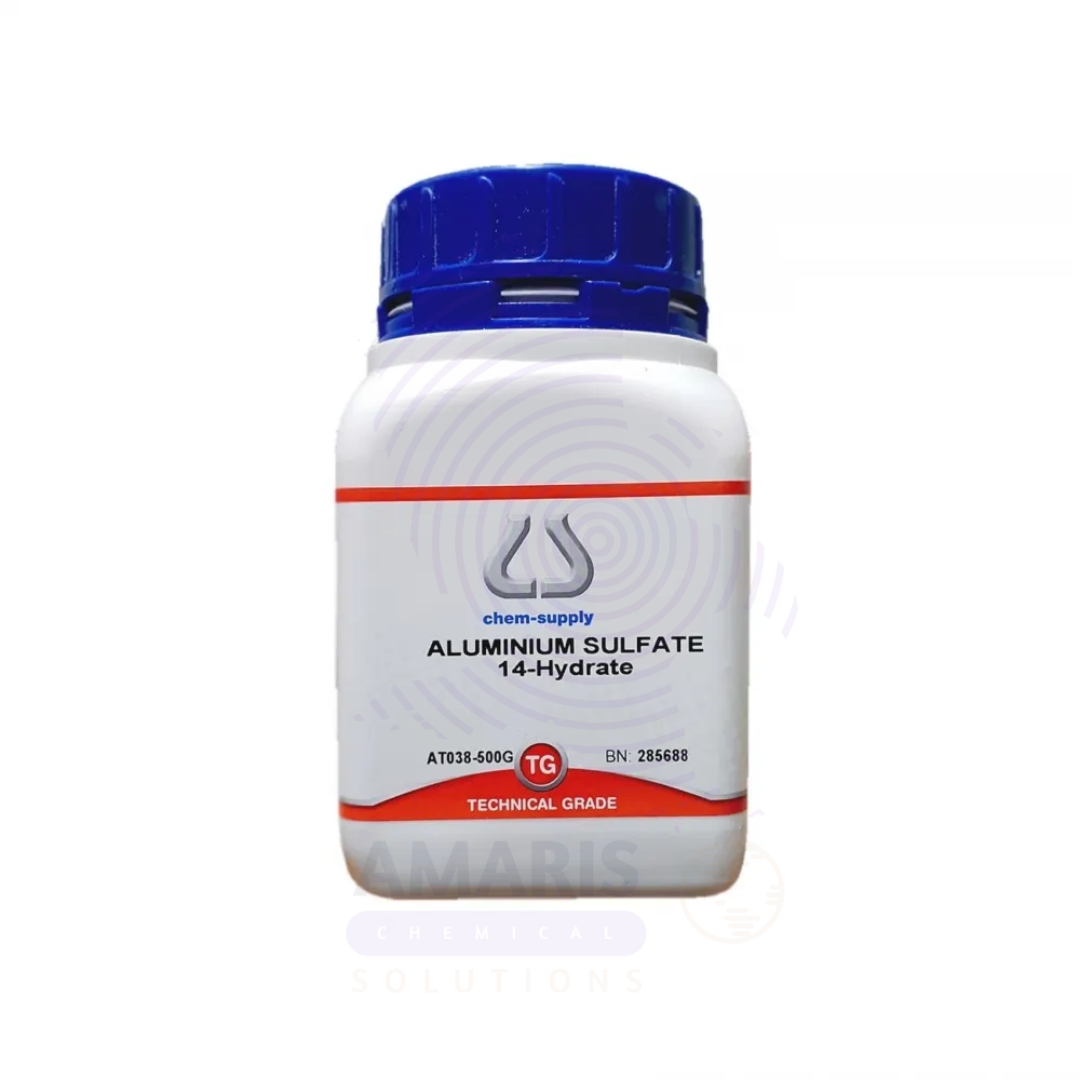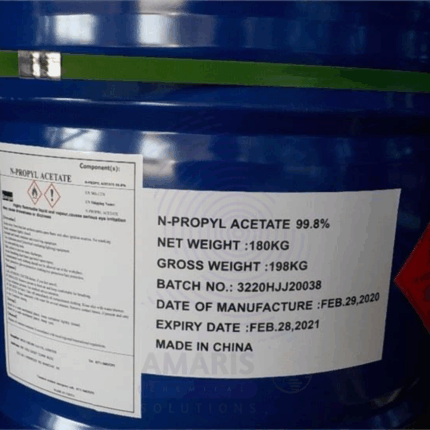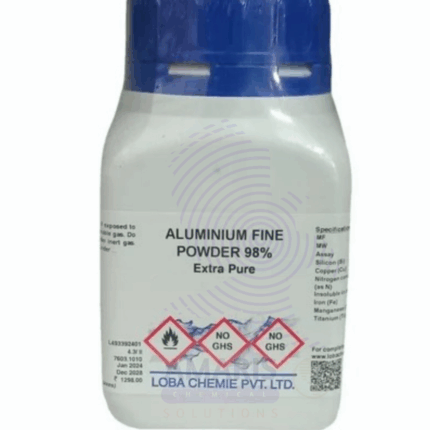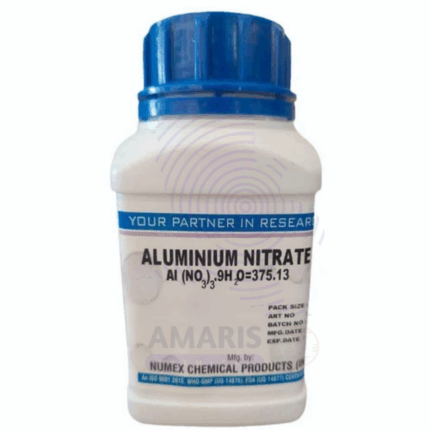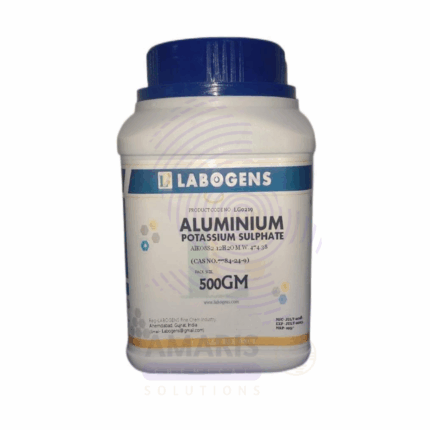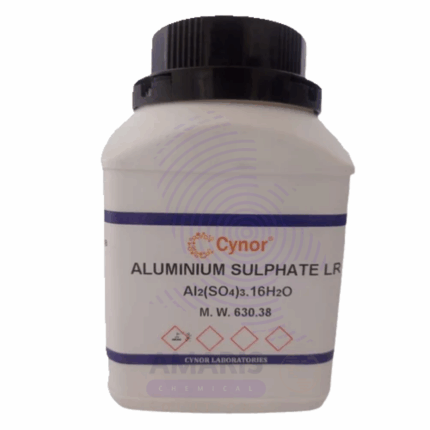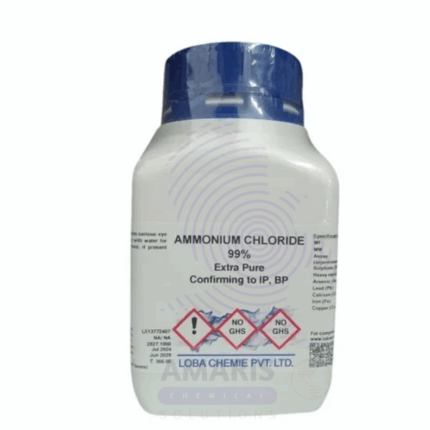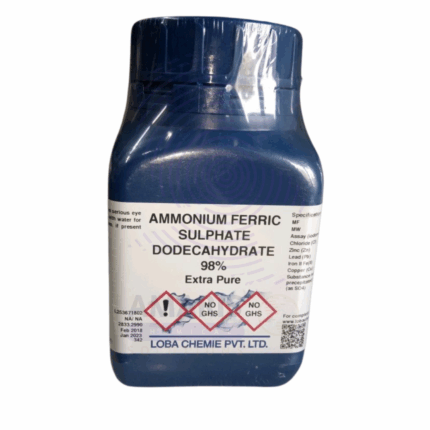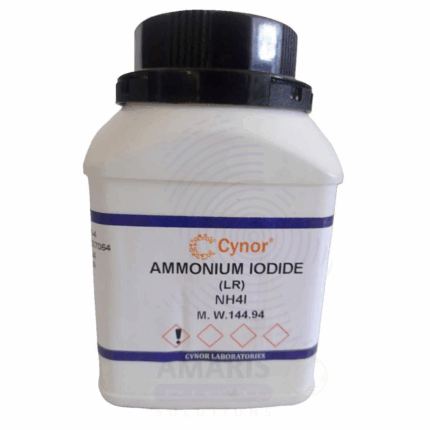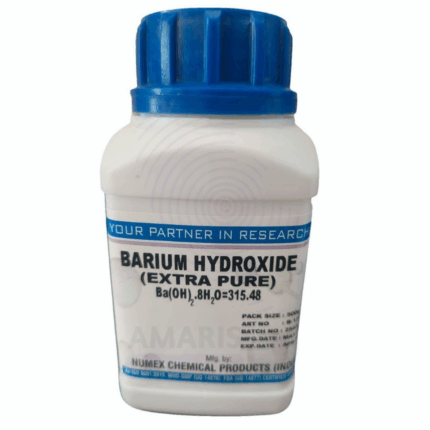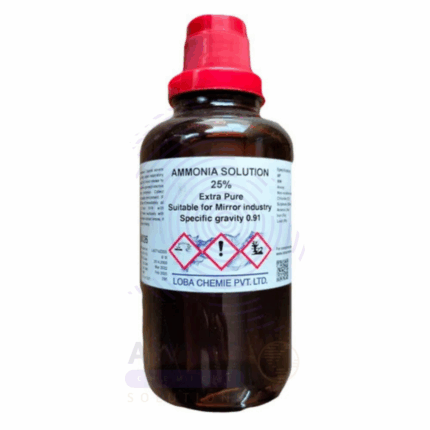
Aluminium Sulphate Hydrous Extra Pure
$ 18.00 Original price was: $ 18.00.$ 17.89Current price is: $ 17.89.
Aluminium Sulphate Hydrous Extra Pure is a high-purity, white to slightly off-white crystalline compound containing bound water molecules, commonly used in laboratory settings for analytical, inorganic, and coordination chemistry. It serves as a reliable source of aluminum ions in aqueous solutions and is frequently employed in precipitation reactions, dye fixation studies, and flocculation experiments. The hydrous form offers improved solubility and ease of handling, making it suitable for educational labs and controlled research environments. Its extra pure grade ensures minimal interference from impurities, enabling accurate, reproducible results in sensitive analytical procedures. To maintain its stability and prevent further hydration or contamination, it should be stored in well-sealed containers in a cool, dry place.
Aluminium Sulphate Hydrous Extra Pure
Primary Uses
- Reagent in Inorganic Qualitative Analysis
- Supplies Al³⁺ ions for precipitation reactions (e.g., with OH⁻ or CO₃²⁻) in classic group analysis procedures.
- Flocculation and Coagulation Studies
- Used in bench-scale simulations of water and wastewater treatment processes to demonstrate removal of suspended solids.
- Hydrolysis and Acid-Base Chemistry
- Demonstrates acidic behavior of metal salts through hydrolysis in water; used in pH and buffer experiments.
- Educational Use in Salt Chemistry and Solubility
- Suitable for student labs exploring solubility, salt reactions, and ionic interactions.
- Preparation of Alum Compounds and Derivatives
- Acts as a precursor in synthesizing double salts like potassium alum or other hydrated aluminum complexes.
Secondary Uses
- Electrolyte for Conductivity Experiments
- Investigated in studies involving ion mobility and conductivity in aqueous salt solutions.
- Model Compound in Environmental Chemistry
- Used in simulated studies of soil acidity, aluminum leaching, or sulfate contamination in ecosystems.
- Corrosion Testing and Surface Chemistry
- Applied in experiments involving metal corrosion under acidic or sulfate-rich conditions.
- Study of Crystallization and Hydration
- Explored in labs focusing on crystallization behavior, hydration-dehydration cycles, and structure of hydrated salts.
- Catalyst Precursor (Research Use)
- Sometimes used in preparing alumina-based catalysts or supports after controlled calcination.
| PACK SIZE |
500 grams Plastic Tin |
|---|
1. Basic Identification Attributes
- Chemical Name: Aluminium Sulphate (Hydrated)
- CAS Number: 10043-01-3 (same as anhydrous form)
- HS Code: 28332200 (Aluminium sulphate)
- Molecular Formula: Al₂(SO₄)₃·xH₂O (commonly Al₂(SO₄)₃·18H₂O or Al₂(SO₄)₃·16H₂O)
- Synonyms:
- Aluminium sulfate hydrate
- Hydrated alum
- Cake alum (commercial grade)
- Alum (when unspecified)
- Dialuminium trisulfate hydrate
2. Physical & Chemical Properties
- Physical State: Solid (crystalline lumps or granules)
- Color & Odor: White to pale grey; odorless
- Boiling Point: Decomposes before boiling
- Melting Point: ~85–90°C (releases water of hydration)
- Density/Specific Gravity: ~1.62–1.7 g/cm³ (hydrated form)
- Solubility:
- Water: Freely soluble (forms acidic solution)
- Alcohol: Insoluble
- pH Level: ~2.0–3.0 (5% aqueous solution)
- Vapor Pressure: Not applicable (non-volatile solid)
- Flash Point: Not flammable
- Autoignition Temperature: Not applicable
- Viscosity: Not applicable
3. Safety & Hazard Attributes
- Hazard Class (GHS):
- Eye Irritation (Category 2)
- Skin Irritation (Category 2)
- Not acutely toxic, but irritant in large quantities or as dust
- NFPA Ratings:
- Health: 2
- Flammability: 0
- Reactivity: 0
- Exposure Limits:
- OSHA PEL: Not established for hydrated form
- Nuisance dust limits apply: 15 mg/m³ (total), 5 mg/m³ (respirable)
- Reactivity:
- Stable in dry form
- Reacts with bases and carbonates to release gas or precipitate
4. Storage & Handling Attributes
- Storage Conditions:
- Keep in sealed containers in a dry area
- Protect from moisture absorption and temperature fluctuations
- Incompatible Materials:
- Strong bases, reactive metals, reducing agents
- Container Type:
- Glass, polyethylene, or fiber drums with liner
- Shelf Life & Expiration Date:
- ~2 years under proper storage
- Special Handling Requirements:
- Use gloves, dust mask, and eye protection when handling powder or granules
- Avoid skin and eye contact with solutions
5. Regulatory & Compliance Attributes
- Regulatory Status:
- Listed under TSCA, REACH
- Commonly accepted in water treatment and laboratory research
- Transportation Restrictions:
- Not classified as hazardous for transport
- Waste Disposal Method:
- Neutralize and dilute before disposal
- Dispose of as non-hazardous inorganic waste unless contaminated
6. Environmental & Health Impact
- Ecotoxicity:
- Mildly toxic to aquatic life at high concentrations
- Alters pH and contributes to aluminium load in effluent
- Persistence in Environment:
- Breaks down into aluminium ions and sulfate
- Carcinogenicity/Mutagenicity:
- Not classified as carcinogenic or mutagenic
- Biodegradability:
- Not biodegradable (inorganic), but environmentally manageable
SAFETY PRECAUTIONS
- Personal Protective Equipment (PPE):
- Wear a lab coat, safety goggles, and chemical-resistant gloves (e.g., nitrile).
- Use a dust mask or respirator when handling powders in open air.
- Handling:
- Avoid contact with eyes and skin.
- Prevent formation of dust and avoid inhalation.
- Use in a well-ventilated area or under a fume hood.
- Do not mix with strong bases—may release heat and form corrosive substances.
- Storage:
- Store in a tightly sealed, labeled container.
- Keep in a cool, dry, and well-ventilated area.
- Protect from moisture, as the hydrous form can absorb additional water and clump.
- Keep away from incompatible substances such as alkalis and reactive metals.
- Hygiene Measures:
- Wash hands thoroughly after handling.
- Avoid touching eyes, mouth, or face during use.
- Do not eat, drink, or smoke in the laboratory.
FIRST AID MEASURES
- Inhalation:
- Move the person to fresh air immediately.
- Rinse mouth and nasal passages with water if dust was inhaled.
- Seek medical attention if respiratory symptoms develop (e.g., coughing, irritation).
- Skin Contact:
- Remove contaminated clothing.
- Wash affected areas with soap and plenty of water.
- Seek medical attention if redness, itching, or irritation occurs.
- Eye Contact:
- Rinse eyes thoroughly with clean water for at least 15 minutes.
- Hold eyelids open during rinsing.
- Seek immediate medical attention if irritation or blurred vision continues.
- Ingestion:
- Rinse your mouth thoroughly with water.
- Do not induce vomiting.
- If fully conscious, give small sips of water.
- Seek immediate medical help—may cause irritation of the gastrointestinal tract.
FIRE FIGHTING MEASURES
- Suitable Extinguishing Media:
- Use water spray, dry chemical, foam, or carbon dioxide (CO₂), depending on the nature of the surrounding fire.
- Specific Hazards:
- Non-flammable and does not support combustion.
- May release irritating sulfur oxides and aluminum oxide upon heating.
- Fire-related runoff may be corrosive or environmentally harmful.
- Protective Equipment for Firefighters:
- Wear full protective clothing and a self-contained breathing apparatus (SCBA).
- Firefighting Instructions:
- Avoid breathing dust, fumes, or vapors from decomposition.
- Cool exposed containers with water spray.
- Contain fire runoff to prevent contamination of drains or waterways.


 Preservatives(food)
Preservatives(food) Flavor Enhancers
Flavor Enhancers Acidulants
Acidulants Sweeteners
Sweeteners Antioxidants
Antioxidants Colorants(food)
Colorants(food) Nutraceutical Ingredients (food)
Nutraceutical Ingredients (food) Nutrient Supplements
Nutrient Supplements Emulsifiers
Emulsifiers
 Collectors
Collectors Dust Suppressants
Dust Suppressants Explosives and Blasting Agents
Explosives and Blasting Agents Flocculants and Coagulants
Flocculants and Coagulants Frothers
Frothers Leaching Agents
Leaching Agents pH Modifiers
pH Modifiers Precious Metal Extraction Agents
Precious Metal Extraction Agents
 Antioxidants(plastic)
Antioxidants(plastic) Colorants (Pigments, Dyes)
Colorants (Pigments, Dyes) Fillers and Reinforcements
Fillers and Reinforcements Flame Retardants
Flame Retardants Monomers
Monomers Plasticizers
Plasticizers Polymerization Initiators
Polymerization Initiators Stabilizers (UV, Heat)
Stabilizers (UV, Heat)
 Antifoaming Agents
Antifoaming Agents Chelating Agents
Chelating Agents Coagulants and Flocculants
Coagulants and Flocculants Corrosion Inhibitors
Corrosion Inhibitors Disinfectants and Biocides
Disinfectants and Biocides Oxidizing Agents
Oxidizing Agents pH Adjusters
pH Adjusters Scale Inhibitors( water)
Scale Inhibitors( water)
 Antioxidants(cosmetic)
Antioxidants(cosmetic) Emollients
Emollients Fragrances and Essential Oils
Fragrances and Essential Oils Humectants
Humectants Preservatives
Preservatives Surfactants(cosmetic)
Surfactants(cosmetic) Thickeners
Thickeners UV Filters
UV Filters
 Fertilizers
Fertilizers Soil Conditioners
Soil Conditioners Plant Growth Regulators
Plant Growth Regulators Animal Feed Additives
Animal Feed Additives Biostimulants
Biostimulants Pesticides (Herbicides, Insecticides, Fungicides)
Pesticides (Herbicides, Insecticides, Fungicides)
 Active Pharmaceutical Ingredients (APIs)
Active Pharmaceutical Ingredients (APIs) Excipients
Excipients Solvents(pharmaceutical)
Solvents(pharmaceutical) Antibiotics
Antibiotics Antiseptics and Disinfectants
Antiseptics and Disinfectants Vaccine Adjuvants
Vaccine Adjuvants Nutraceutical Ingredients (pharmaceutical)
Nutraceutical Ingredients (pharmaceutical) Analgesics & Antipyretics
Analgesics & Antipyretics
 Analytical Reagents
Analytical Reagents Solvents(lab)
Solvents(lab) Chromatography Chemicals
Chromatography Chemicals Spectroscopy Reagents
Spectroscopy Reagents microbiology-and-cell-culture-reagents
microbiology-and-cell-culture-reagents Molecular Biology Reagents
Molecular Biology Reagents Biochemical Reagents
Biochemical Reagents Inorganic and Organic Standards
Inorganic and Organic Standards Laboratory Safety Chemicals
Laboratory Safety Chemicals Specialty Laboratory Chemicals(Special Laboratory Equipment)
Specialty Laboratory Chemicals(Special Laboratory Equipment)
 Demulsifiers
Demulsifiers Hydraulic Fracturing Fluids
Hydraulic Fracturing Fluids Scale Inhibitors(oil)
Scale Inhibitors(oil) Surfactants(oil)
Surfactants(oil) Drilling Fluids
Drilling Fluids
 Dyes and Pigments
Dyes and Pigments Bleaching Agents
Bleaching Agents Softening Agents
Softening Agents Finishing Agents
Finishing Agents Antistatic Agents
Antistatic Agents
 Admixtures
Admixtures Waterproofing Agents
Waterproofing Agents Sealants and Adhesives
Sealants and Adhesives Curing Compounds
Curing Compounds Concrete Repair Chemicals
Concrete Repair Chemicals Anti-Corrosion Coatings
Anti-Corrosion Coatings
 Surfactants(cleaning)
Surfactants(cleaning) Builders
Builders Enzymes
Enzymes Solvents (Cleaning)
Solvents (Cleaning) Fragrances
Fragrances
 Electronic Chemicals
Electronic Chemicals Catalysts
Catalysts Lubricants
Lubricants Photographic Chemicals
Photographic Chemicals Refrigerants
Refrigerants Automotive chemicals
Automotive chemicals Pyrotechnic Chemicals
Pyrotechnic Chemicals
 Biodegradable Surfactants
Biodegradable Surfactants Bio-based Solvents
Bio-based Solvents Renewable Polymers
Renewable Polymers Carbon Capture Chemicals
Carbon Capture Chemicals Wastewater Treatment Chemicals
Wastewater Treatment Chemicals
 Pigments
Pigments Solvents(paint)
Solvents(paint) Specialty Coatings
Specialty Coatings Binders/Resins
Binders/Resins Additives
Additives Driers
Driers Anti-Corrosion Agents
Anti-Corrosion Agents Functional Coatings
Functional Coatings Application-Specific Coatings
Application-Specific Coatings
 Fresh Herbs
Fresh Herbs Ground Spices
Ground Spices Whole Spices
Whole Spices Spice Blends
Spice Blends Dried Herbs
Dried Herbs
 Leavening Agents
Leavening Agents Dough Conditioners
Dough Conditioners Flour Treatments
Flour Treatments Fat Replacers
Fat Replacers Decoratives
Decoratives Preservatives(baking)
Preservatives(baking)
 Plasticizers & Softeners
Plasticizers & Softeners Reinforcing Agents
Reinforcing Agents Adhesion Promoters
Adhesion Promoters Vulcanizing Agents
Vulcanizing Agents Antidegradants
Antidegradants Blowing Agents
Blowing Agents Fillers & Extenders
Fillers & Extenders Accelerators & Retarders
Accelerators & Retarders